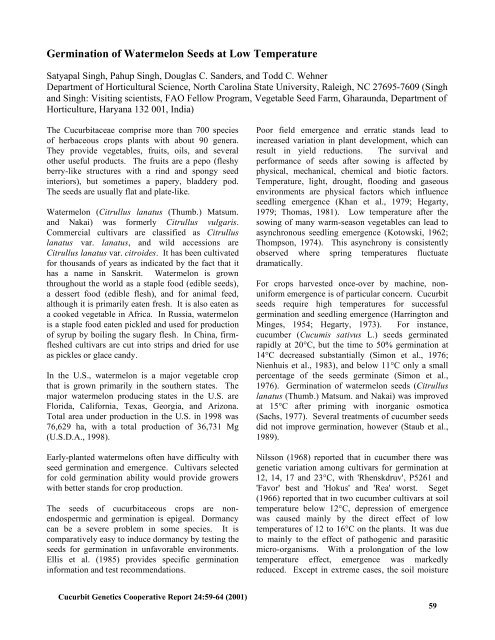Complete volume with articles 1 to 35 - Cucurbit Breeding - North ...
Complete volume with articles 1 to 35 - Cucurbit Breeding - North ...
Complete volume with articles 1 to 35 - Cucurbit Breeding - North ...
Create successful ePaper yourself
Turn your PDF publications into a flip-book with our unique Google optimized e-Paper software.
Germination of Watermelon Seeds at Low Temperature<br />
Satyapal Singh, Pahup Singh, Douglas C. Sanders, and Todd C. Wehner<br />
Department of Horticultural Science, <strong>North</strong> Carolina State University, Raleigh, NC 27695-7609 (Singh<br />
and Singh: Visiting scientists, FAO Fellow Program, Vegetable Seed Farm, Gharaunda, Department of<br />
Horticulture, Haryana 132 001, India)<br />
The <strong>Cucurbit</strong>aceae comprise more than 700 species<br />
of herbaceous crops plants <strong>with</strong> about 90 genera.<br />
They provide vegetables, fruits, oils, and several<br />
other useful products. The fruits are a pepo (fleshy<br />
berry-like structures <strong>with</strong> a rind and spongy seed<br />
interiors), but sometimes a papery, bladdery pod.<br />
The seeds are usually flat and plate-like.<br />
Watermelon (Citrullus lanatus (Thumb.) Matsum.<br />
and Nakai) was formerly Citrullus vulgaris.<br />
Commercial cultivars are classified as Citrullus<br />
lanatus var. lanatus, and wild accessions are<br />
Citrullus lanatus var. citroides. It has been cultivated<br />
for thousands of years as indicated by the fact that it<br />
has a name in Sanskrit. Watermelon is grown<br />
throughout the world as a staple food (edible seeds),<br />
a dessert food (edible flesh), and for animal feed,<br />
although it is primarily eaten fresh. It is also eaten as<br />
a cooked vegetable in Africa. In Russia, watermelon<br />
is a staple food eaten pickled and used for production<br />
of syrup by boiling the sugary flesh. In China, firmfleshed<br />
cultivars are cut in<strong>to</strong> strips and dried for use<br />
as pickles or glace candy.<br />
In the U.S., watermelon is a major vegetable crop<br />
that is grown primarily in the southern states. The<br />
major watermelon producing states in the U.S. are<br />
Florida, California, Texas, Georgia, and Arizona.<br />
Total area under production in the U.S. in 1998 was<br />
76,629 ha, <strong>with</strong> a <strong>to</strong>tal production of 36,731 Mg<br />
(U.S.D.A., 1998).<br />
Early-planted watermelons often have difficulty <strong>with</strong><br />
seed germination and emergence. Cultivars selected<br />
for cold germination ability would provide growers<br />
<strong>with</strong> better stands for crop production.<br />
The seeds of cucurbitaceous crops are nonendospermic<br />
and germination is epigeal. Dormancy<br />
can be a severe problem in some species. It is<br />
comparatively easy <strong>to</strong> induce dormancy by testing the<br />
seeds for germination in unfavorable environments.<br />
Ellis et al. (1985) provides specific germination<br />
information and test recommendations.<br />
<strong>Cucurbit</strong> Genetics Cooperative Report 24:59-64 (2001)<br />
Poor field emergence and erratic stands lead <strong>to</strong><br />
increased variation in plant development, which can<br />
result in yield reductions. The survival and<br />
performance of seeds after sowing is affected by<br />
physical, mechanical, chemical and biotic fac<strong>to</strong>rs.<br />
Temperature, light, drought, flooding and gaseous<br />
environments are physical fac<strong>to</strong>rs which influence<br />
seedling emergence (Khan et al., 1979; Hegarty,<br />
1979; Thomas, 1981). Low temperature after the<br />
sowing of many warm-season vegetables can lead <strong>to</strong><br />
asynchronous seedling emergence (Ko<strong>to</strong>wski, 1962;<br />
Thompson, 1974). This asynchrony is consistently<br />
observed where spring temperatures fluctuate<br />
dramatically.<br />
For crops harvested once-over by machine, nonuniform<br />
emergence is of particular concern. <strong>Cucurbit</strong><br />
seeds require high temperatures for successful<br />
germination and seedling emergence (Harring<strong>to</strong>n and<br />
Minges, 1954; Hegarty, 1973). For instance,<br />
cucumber (Cucumis sativus L.) seeds germinated<br />
rapidly at 20°C, but the time <strong>to</strong> 50% germination at<br />
14°C decreased substantially (Simon et al., 1976;<br />
Nienhuis et al., 1983), and below 11°C only a small<br />
percentage of the seeds germinate (Simon et al.,<br />
1976). Germination of watermelon seeds (Citrullus<br />
lanatus (Thumb.) Matsum. and Nakai) was improved<br />
at 15°C after priming <strong>with</strong> inorganic osmotica<br />
(Sachs, 1977). Several treatments of cucumber seeds<br />
did not improve germination, however (Staub et al.,<br />
1989).<br />
Nilsson (1968) reported that in cucumber there was<br />
genetic variation among cultivars for germination at<br />
12, 14, 17 and 23°C, <strong>with</strong> 'Rhenskdruv', P5261 and<br />
'Favor' best and 'Hokus' and 'Rea' worst. Seget<br />
(1966) reported that in two cucumber cultivars at soil<br />
temperature below 12°C, depression of emergence<br />
was caused mainly by the direct effect of low<br />
temperatures of 12 <strong>to</strong> 16°C on the plants. It was due<br />
<strong>to</strong> mainly <strong>to</strong> the effect of pathogenic and parasitic<br />
micro-organisms. With a prolongation of the low<br />
temperature effect, emergence was markedly<br />
reduced. Except in extreme cases, the soil moisture<br />
59

















